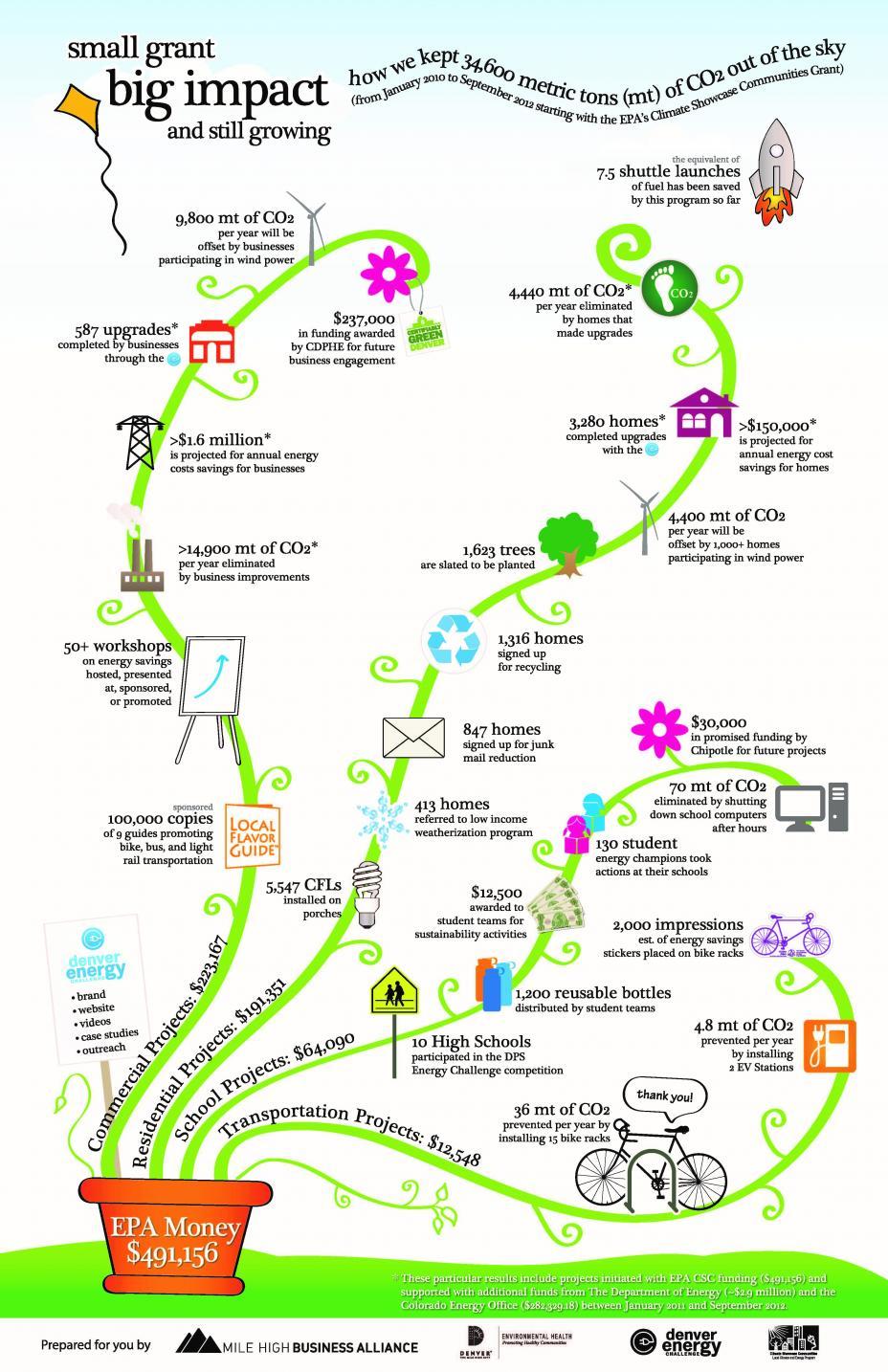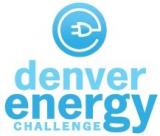Denver Energy Challenge (DEC) Small Grant, Big Impact
Denver, Colorado |
|---|
Learn about other climate showcase communities.
The Denver Energy Challenge (DEC) is an integrated portfolio of replicable, neighborhood-scale greenhouse gas (GHG) reduction efforts to help businesses and residents save energy and money. The program, which has been driven by Denver's 2007 Climate Action Plan, has created jobs, supported economic opportunities, and fostered a healthier and more livable community.
The DEC grew out of a community desire to reduce GHG emissions and engage local residents. The project began in early 2010 and continued through September 2012 with a Climate Showcase Communities (CSC) grant from EPA. The efforts will continue beyond the scope of the CSC grant with funding and support from U.S. Department of Energy’s (DOE) State Energy Program and the Denver Department of Environmental Health.
On this page:
Multiple Initiatives, One Brand
The DEC program includes commercial, residential, school, and transportation projects to increase energy efficiency throughout the City and County of Denver. The four focus areas were initially introduced as separate programs with unique services and names. However, potential partners found this division confusing and the project realized the benefits of rebranding under the current DEC name. Although branding was unified, the projects remained individualized.
 Figure 1 - Allocation of Resources and Environmental Impacts of Each Focus Area: Commercial, Residential, School, and Transportation. (Mile High Business Alliance, 2014)
Figure 1 - Allocation of Resources and Environmental Impacts of Each Focus Area: Commercial, Residential, School, and Transportation. (Mile High Business Alliance, 2014)
Commercial Projects provided small businesses with opportunities to increase energy efficiency in their operations. The DEC implemented these projects through three actions: (1) education and support for the small business community; (2) small business efficiency implementation assistance; and (3) development of branding and recognition for small business participants. Branding allowed the DEC to work at the neighborhood level to help people identify “green” business or transportation options.
Residential Projects focused on reducing GHG emissions through neighborhood action and utilized the Neighborhood Energy Action Partnership (NEAP) to maximize community outreach. The key actions for this focus area included coordinating with NEAP to reach Denver neighborhoods to provide targeted energy efficiency and conservation programs; hosting a series of community energy workshops and outreach events; and integrating outreach and workshops with Denver’s single-family and multi-family weatherization efforts.
School Projects aimed to reduce energy consumption through student competition and sustainability initiatives. Between the launch and final implementation of these initiatives, the DEC team changed its focus to ensure that lower income neighborhoods benefit equally from the program. This shift in focus emphasized collaboration with Denver Public Schools to provide a more robust and successful school challenge that aimed to educate and engage high school students throughout the city, rather than conduct an energy makeover for a select few neighborhoods. The program ultimately consisted of three actions: (1) initiating a City-wide Clean Energy Challenge for community participation in Windsource Xcel Energy’s voluntary renewable energy program Exitfor a small premium over the cost of the regular electricity mix; (2) devoting funding to Denver Public Schools for a School Energy Challenge for every Windsource participant (Xcel Energy provided matching funds); and (3) modifying and developing a similar program for elementary schools.
 Figure 1 - Allocation of Resources and Environmental Impacts of Each Focus Area: Commercial, Residential, School, and Transportation. (Mile High Business Alliance, 2014)Transportation Projects — with less than $10k, the team defined actions that would produce notable results with very little funding. To implement this part of the program, the project team completed three action items: (1) facilitating increased use of alternative transportation through incentives and neighborhood assistance programs, including the installation of 15 bike racks for businesses; (2) promoting business transportation best practices; and (3) installing two public charging stations to facilitate the use of electric vehicles.
Figure 1 - Allocation of Resources and Environmental Impacts of Each Focus Area: Commercial, Residential, School, and Transportation. (Mile High Business Alliance, 2014)Transportation Projects — with less than $10k, the team defined actions that would produce notable results with very little funding. To implement this part of the program, the project team completed three action items: (1) facilitating increased use of alternative transportation through incentives and neighborhood assistance programs, including the installation of 15 bike racks for businesses; (2) promoting business transportation best practices; and (3) installing two public charging stations to facilitate the use of electric vehicles.
Grants, In-kind Assistance, and Matching Funds
The DEC obtained funding from a combination of State and Federal grant sources, as well as in-kind and matching funds from contracts. The program used EPA’s CSC grant funding, in tandem with other sources, to pay for direct project facilities (e.g., bike racks), personnel (e.g., program implementation, data, project management) and indirect costs (contract and grant management related support services). Initially, the DEC primarily used volunteers to disseminate messaging and other information about the program. As the project progressed, however, the DEC moved toward using contractors to improve consistency in messaging. For example, they hired Mile High Business Alliance to utilize its existing material on transportation and energy efficiency to reach out to small businesses.
Local Action
The goals for the project were driven by Denver’s 2007 Climate Action Plan and informed by stakeholder outreach. The DEC tapped into stakeholder networks and worked with non-profits to understand what businesses, residents, and schools wanted in the program. Through this outreach, they decided that commercial and residential energy projects needed to be broken into separate areas in order to maximize impact.
While program actions were informed by community outreach, they grew largely in response to the availability of funding.
Measure Success
The program measured a variety of statistics including energy consumption, vehicle miles avoided, and participant outreach. To address privacy concerns, the DEC had individual participants sign release forms to give the utility provider permission to send the DEC the requested baseline data. The regional government provided public transportation use data. The DEC found it very useful to have one point person familiar with the metrics tracking system. To analyze measurable data, the team used a Salesforce.com customer management system to track metrics and generate reports quickly. The DEC found that data management, while resource intensive, proved an effective way to communicate the success of the program.
Draw on Existing Resources to Learn and Promote
Rather than recreating the wheel, the DEC leveraged an existing neighborhood energy action partnership as a program starting point. Once the program was up and running, they made a concerted effort to continue to attend community group meetings and promote the program. Additionally, the team worked with the sustainability director at Denver Public Schools to understand the types of information that would speak to students in the classroom. They promoted different focus areas of the program based on the community events that program representatives attended. For example, outreach at farmer’s markets focused on the residential and transportation sides of the program, while outreach at trade shows focused on the commercial sector.
Next Steps
By demonstrating its success with these programs, Denver obtained new grants and longer term funding sources to continue and expand the project. The team also leveraged financial savings from the energy efficiency upgrades to fund program continuity. The City’s continued support will help ensure that the energy efficiency market will continue to grow and develop in the commercial and residential sectors and beyond. Beyond the scope of the CSC grant, the City and County of Denver Department of Environmental Health will provide energy and sustainability support for small businesses through the Certifiably Green Denver Exit program. With the assistance of a $270k state award, this program will support small businesses in four targeted North Denver Neighborhoods (Cole, Clayton, Elyria-Swansea, and Globeville). The Department of Environmental Health will also continue residential energy efficiency programming under the Denver Energy Challenge brand. The City of Denver has also been selected as a participant in the City Energy Project Exit , a city-scale energy efficiency initiative run by the National Resources Defense Council, in part due to the city’s established infrastructure and demonstrated ability to scale up efforts to accommodate larger buildings and companies.
Replication
Staff Needs: 3-4 full time equivalent staff members
Cost: The total cost of the program was funded through multiple sources: the CSC grant ($491,156), the DOE State Energy Program (roughly $2.9 million), the Colorado Energy Office ($282,329), and roughly $3.7 million from a Denver Energy Efficiency revolving fund for continuing the loan program.
Scalability: The City of Denver now has a sustainable neighborhoods program Exit that is replicating the Denver Energy Challenge on a smaller scale by engaging the community at the neighborhood level, learning about their needs and goals, and connecting them with the resources they need to meet their own goals. Simultaneously, Denver’s participation in the City Energy Project provides the City with the opportunity to demonstrate how to use the DEC framework on a larger scale. As part of this program, Denver is one of ten United States cities paving the way for city-scale energy efficiency by focusing on large, historically-inefficient buildings.
Available Resources:
- City and County of Denver Climate Action Plan (PDF) (40 pp, 18.4 M, About PDF)Exit
- Denver Public Schools Energy Challenge Materials Exit
Learn from Similar Climate Showcase Communities Programs:
Contact Information
Denver Energy Challenge
720-865-5430
Contact Us Exit

